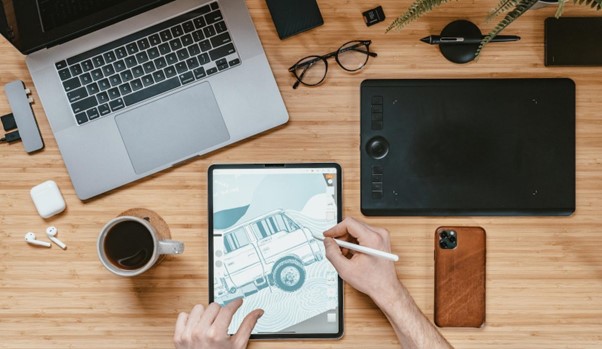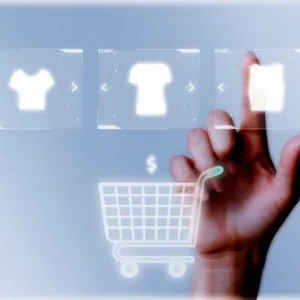There are so many entrepreneurs who make fantastic products and then wonder why their “change the world” idea isn’t changing the world.
That, my friends, is why branding is so important, and why marketers charge obscene amounts of money for what on the surface appears to be an easy job.
As an add-on to that, a massive part of marketing and brand management is designed: right up from the logo of your company, down to the font that one uses in all brand materials.
If I am driving past a billboard or flicking through the channels on TV, you only have my attention for a few fleeting seconds.
In that time, you must grab my attention enough for me to drop what I’m doing and pay rapt attention to your brand.
That is where digital design comes in: you need to manage your brand and not just a product.
In this article, I will talk to you about what branding is, how to build your brand through design, and how to not break the bank while doing so.
What is Digital Design In Terms Of Branding?
Digital design is the process of making your brand more visible to people through technological mediums.
It covers a lot of aspects and includes things like logo design, choosing brand colors, and, depending on who you ask, UI and UX design too. (UI and UX stand for User Interface and User Experience, respectively.
Thus, for the purposes of this article, we will define digital design as being the following:
- Marketing Design
- Brand Design
- Product User Interface Design
- End User Experience Design
I will talk to you about each of these as the article progresses.
How Costly Is Digital Design These Days?
With growing awareness, any digital designer tends to charge you an arm and a leg, in addition to your firstborn child.
Here are some references:
PayScale.Com says that the average third quartile of UX designers earns a median of USD 76,327 per year, excluding benefits.
GlassDoor tells us that the average salary for a Digital Designer is USD 68,132 per year in areas that are not IT hubs. In those areas, it frequently touches six figures.
Indeed puts the digital designer’s annual average salary at USD 71,267 per annum.
Comparably has been published that Marketing Designers typically earn USD 73.757 each year, on average.
That is a considerable chunk of change, especially for new ventures like startups.
However, it doesn’t have to be this way: I have a hack.
With covid, so many businesses went online that even the people who serve these businesses did so too.
Thus, by outsourcing design, one can take advantage of a talent pool that does not have geographical limitations, a truly global talent bank, for a fraction of the price.
Companies now provide digital design services for a fraction of the 2022 average prices that I have listed above.
If you outsource your design, you can get rates starting from USD 25 per hour and even get individual element pricing for your brand.
Outsourcing is an amazing way to save money, and a pro tip from me is that it is not just designed you can outsource — websites and even the content for the site can also be outsourced.
How Digital Design Affects Your Brand
Let us now dive deeper into how each of the four aspects of design that I mentioned earlier has an effect on your brand image.
1. Marketing Design
Kicking things off with marketing and market campaign design, I should mention that you are not simply up against your industry when marketing digitally.
You are also in competition with any form of digital content or interference that could divert your customer/visitors’ attention.
Having a high-quality, well-designed marketing campaign (both graphical and planned out) will turn out to be an amazing tool in your arsenal.
There are several spheres that one can play with in the online marketing space. Some of your options here are:
- Email Marketing
- Social Media Advertisements
- Banner Advertisements
- Videography
A good marketing designer will help project your company as one of the leading brands in its sector.
Marketing design is extremely important for any company, but even more so if you are in an online space in any capacity.
A few tricks to designing your marketing campaign well:
- Use bright colors that “pop” — and if possible, try to use colors that complement (or accent) the primary colors of your company.
- Make all your CTA (call to action) buttons easily visible and they should preferably be of the same shade for easy usability.
- Steer clear of stock photography — it is a far better option to use custom photographs or bespoke illustrations. However, if you must use stock photos, try to look for ones that are not obviously commercial photographs.
- Keep your pictures to the proper resolution and size: large pictures make your marketing communication load slower and no one wants that.
- Less is more when it comes to copy. “Copy” means all the written content that you include in your campaign. Don’t use more than you need to, because, let’s face it: no one is going to devour every word you write, so stick to the point.
2. Brand Design
Brand design is something that encompasses how your company is perceived in the eye of the public.
It includes the following:
- Website Design: More often than not, your website is one of the first things that people see when looking up your company. In the case of startup ventures, it is vital to create a (good) lasting first impression, which is where a well-designed website comes into play.
- Color Selection: Choosing your brand color template and swatches. Making sure that your company has unique, recognizable colors across all places makes people associate your brand with that color/ color combination. Example: Ferrari and the color red.
- Front Office Management: it is important to design a front office SOP (standard operating procedure) that makes the people who contact your company feel satisfied. Your front office does not have to be physical — these days it includes people who are on your customer support team, client outreach team, and anyone who communicates with people outside the organization.
The brand design also covers building a brand environment that is both fun and conducive to work, but that is a topic for another day.
3. UI And UX Design
UI stands for User Interface and UX stands for User Experience.
User interface (UI) and user experience (UX) Designers are some of the most sought-after people in today’s fast-paced scenario. UI is usually stated with respect to some form of the online market such as an app or website.
UX design however applies to both the physical as well as the digital world.
Chances are, as a startup, you also have an app in addition to your website. This is where I would recommend taking the help of a design professional to achieve a balance between simplicity, ease of use, and features.
You want a designer to use colors, pictures, features, and elements that do not interfere with the website/app’s performance in any way, but that is still pleasing to look at.
This is especially important if you do not have a physical storefront — because if this is the case, then your website or app is the only image that unconverted customers have of your startup.
It is the same situation as with brand image: Kentucky Fried Chicken does not need to tell people why it needs to be around — your startup does.
Similarly, KFC could probably get away with a bad website and app, but if a small business has poorly designed things, that may very well translate to lost potential customers.
I have noticed that some startups do things brilliantly and then mess up here, in the product UI and UX design.
Here are my keys to success:
- Incorporate a designer or include design considerations early on while making the product or service. It is much harder to design brand materials around a product than the reverse.
- Ensure that your app and website are both dark mode compatible, given that so many people are using dark mode these days.
- Your call-to-action buttons should be of a contrasting color to your website’s colors.
- Rely on a bootstrap UI Kit to enhance the UI of your website.
This is the exact opposite of what I told you the CTA button should be like in marketing materials like emails because those are mostly copied, but websites and apps have other elements that will probably follow your brand color template, and you want the call to action to stand out, not fit in.
Lastly, ensure that your call to action has only one function (get in touch, go here, do this, etc) and not more, or else you mess up the inbound flywheel funnel and risk “unhooking” the customer.
Startups And Design: Is That It?
Pretty much. There is a lot more, but you do not need a Ph.D. in design to make your product a success — the basics contained in this article are enough to get you building.
I am not saying that I have written a comprehensive guide, but this piece is a good starting point.
Quality design will protect your business as being more professional, more trustworthy, and more businesslike.
It helps your brand build more lasting relationships with customers, and good design also enhances the usefulness (useability) of your product and/ or services.
After all, as someone said, “design adds value faster than it adds costs”.





